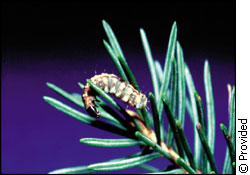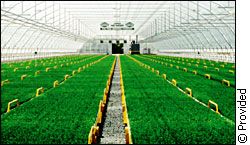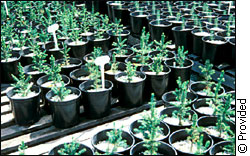| Bringing
down the budworm
By Katie Lewis
OTTAWA —
Every few decades, the eastern
spruce budworm, choristoneura fumiferana, ravages
forests throughout Canada and the United States. One
local scientist has had enough – and he's using
an age-old idea to banish the budworm.
He's using nature to fight nature.
The little worm that could
 |
| Choristoneura
fumiferana, or eastern spruce budworm. |
The budworm has a long history in Canada
– with natural cycles occuring every thirty years
or so over the last couple of centuries. It has gradually
developed a resistance to chemical pesticides.
Dr. David Miller, a Carleton University
Researcher in Biochemistry, is looking for an alternative
way to banish the budworm. He says his research has
shown him that an enemy of the budworm is a family of
needle-loving fungi.
| 'It’s like
looking for a needle in a haystack and you don’t
know what the needle looks like.' |
Dr. Miller says the idea of using fungi
against the budworm occurred when he went to a Colorado
conference and a colleague wondered aloud if it was
possible that endophytes – which are fungi living
inside conifer needles – may produce toxins which
work against the budworm.
"Science, like everything else in
life, works on some kind of trade basis," says
Miller. "They traded me something, which was an
idea, and the return they got was somebody who actually
knew how to figure out if this was true.
Looking for evidence
For the past 20 years, Miller has worked
on uncovering the answer . Through his research, he
found 90 to 95 per cent of the endophytes living in
the spruce trees did not produce toxins, but that 5
to 10 per cent produced toxins that worked against the
budworm
 |
| Dr. David Miller, Carleton University. |
Older trees which had survived budworm
outbreaks had larger amounts of these toxins. The endophytes
which didn’t produce toxins were known as "cheaters."
Miller says, although the idea sounds
simple, it was incredibly risky at the time. He says
he was pleased with the way the grant system in Canada
worked, considering the difficult research he was undertaking.
" It’s like looking
for a needle in a haystack and you don’t know
what the needle looks like," says Miller. "It
was that hard. It was so risky in the probability of
success."
Convincing the company
Miller’s next step was to convince
a forest company to help him with his research. He was
looking for seedlings to experiment with.
| 'In terms of the
breeding population, the way you’d need to
think about it, is if you have 13 kids and I needed
to kill one of them you’d still have 12, but
it’s not like it’s a small thing.' |
"We needed a breeding population
of white spruce trees, about 6000 of them, and there’s
only one organization on the planet that has them. It
took a while to convince them to give those up."
Miller did end up convincing forestry
company J.D. Irving Limited to supply the trees after
his research was peer reviewed and the science was found
to be sound.
He was asking J.D. Irving Limited to
give up a large portion of their best and rare conifers
through a tree improvement program. However, if the
research worked, the company would be rewarded with
an ability to have well-protected seedlings forever.
 |
| White spruce tree greenhouse. |
"In terms of the breeding
population, the way you’d need to think about
it, is if you have 13 kids and I needed to kill one
of them you’d still have 12, but it’s not
like it’s a small thing. It was a big thing"
Miller experimented using several different
methods of injection as a way to introduce "good"
endophyte cells into the seedlings. At the end of this
part of the project, 200 seedlings from a total of 6000
showed that they had been colonized. The "good"
endophyte inoculations were successful.
Although the number was low, Miller says
it was an important stepping stone. First, he realized
it could be done. Second, he found out what types of
injection worked best.
Educated at the University of New Brunswick
as well as the University of Portsmouth in England where
he was a NATO science postdoctoral fellow, Miller is
now part of the Chemistry faculty at Carleton and is
the the NSERC Industrial Research Chair Fungal Toxins
and Allergens. He’s worked at Agriculture Canada,
and is currently a visiting scientist with Health.
The next step
 |
| The collection of white spruce
trees. |
Miller says his journey to get rid of
the budworm is not over yet. He’s been working
on the project since he was 28, and says he hopes that
the end is in sight in about three years. At this point,
the company could start doing injections on the majority
of its spruce trees.
However, he’s tentative to formally
pin down a date, as new things might come up, and new
discoveries could be made. He says the biggest virtue
of any scientist is patience.
"It’s a very long journey,"
says Miller. "That’s relatively typical in
science. You have to be patient and have a long view
of things."
|